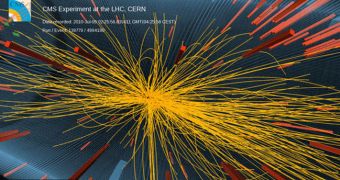While most of the scientists working at the Large Hadron Collider (LHC) expected to further the boundaries of physics as they did so, very few expected this to happen this fast. It would appear that a never-before-seen phenomenon has been observed at the accelerator.
According to reports, it would seem that operators on one of the three main particle detectors that exist along the accelerator's 27-kilometer-long tunnels discovered a series of interactions that are new to physics.
The experts say that they saw the previously-unobserved phenomenon during proton-proton collisions. The detector is placed in a spot where the beams accelerated through the tunnels cross each other.
The type of science now being conducted at the LHC is groundbreaking, given that no other installation is capable of producing such energetic particles as the CERN facility.
Its superconducting magnets are capable of accelerating protons to energy levels of up to 7 teraelectronvolts (TeV) per beam, for a combined output of 14 TeV. At this point, collisions take place at 3.5 TeV per beam, Universe Today reports.
The new discovery was made by a team operating the Compact Muon Solenoid (CMS) detector. The experts say colliding protons that were intimately linked, in a way that was never seen before in this type of collisions.
Before the LHC reached a total energy output level of 7 TeV, such events were not discovered. This hints at the fact that only energy levels above that threshold reveal the mysterious phenomenon.
“The new feature has appeared in our analysis around the middle of July,” explains CMS physicist Guido Tonelli, who spoke a seminar presenting the findings to colleagues at CERN.
The European Organization for Nuclear Research (CERN) manages the LHC, and is the primary actor in its construction. It houses the particle accelerator underground, near the Swiss-French border.
“Now we need more data to analyze fully what’s going on, and to take our first steps into the vast landscape of new physics we hope the LHC will open up,” Tonelli added.
At this time, official time lines suggest that the accelerator will continue collisions at this energy output until at least the end of October.
Starting in November, or December at the latest, the protons the LHC currently accelerates will be replaced by lead nuclei, officials at CERN say.

 14 DAY TRIAL //
14 DAY TRIAL //